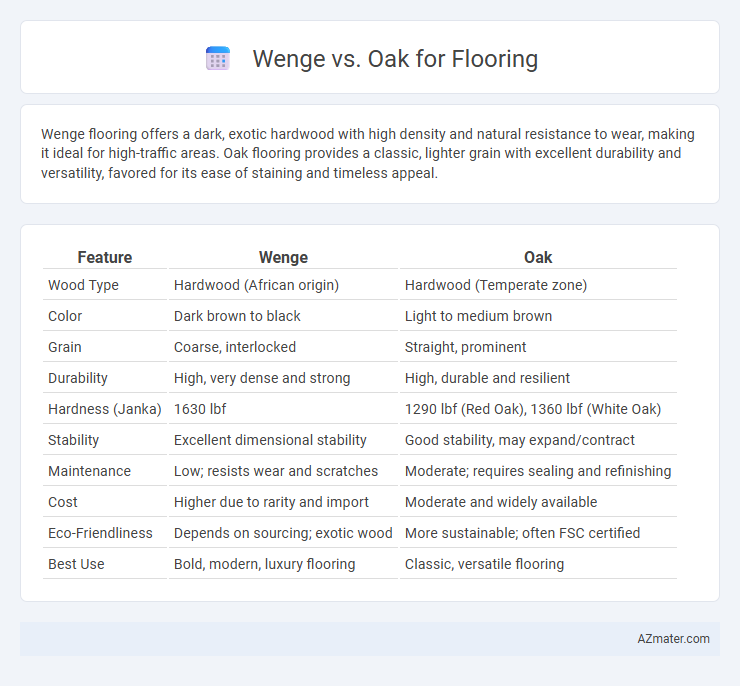Wenge flooring offers a dark, exotic hardwood with high density and natural resistance to wear, making it ideal for high-traffic areas. Oak flooring provides a classic, lighter grain with excellent durability and versatility, favored for its ease of staining and timeless appeal.
Table of Comparison
| Feature | Wenge | Oak |
|---|---|---|
| Wood Type | Hardwood (African origin) | Hardwood (Temperate zone) |
| Color | Dark brown to black | Light to medium brown |
| Grain | Coarse, interlocked | Straight, prominent |
| Durability | High, very dense and strong | High, durable and resilient |
| Hardness (Janka) | 1630 lbf | 1290 lbf (Red Oak), 1360 lbf (White Oak) |
| Stability | Excellent dimensional stability | Good stability, may expand/contract |
| Maintenance | Low; resists wear and scratches | Moderate; requires sealing and refinishing |
| Cost | Higher due to rarity and import | Moderate and widely available |
| Eco-Friendliness | Depends on sourcing; exotic wood | More sustainable; often FSC certified |
| Best Use | Bold, modern, luxury flooring | Classic, versatile flooring |
Introduction: Wenge vs Oak Flooring
Wenge flooring offers a rich, dark brown hue with distinctive grain patterns, creating a luxurious and contemporary atmosphere. Oak flooring, known for its durability and lighter, warm tones, provides versatile design options suitable for both traditional and modern interiors. Comparing Wenge and Oak highlights differences in color intensity, hardness, and maintenance needs, guiding a choice that balances aesthetic appeal and functionality.
Overview of Wenge and Oak Wood
Wenge wood, known for its deep brown to black color with distinctive dark streaks, offers exceptional hardness and durability, making it a favorite for high-traffic flooring. Oak wood, originating from the Quercus genus, features a classic light to medium brown tone with prominent grain patterns and unparalleled strength, commonly used in traditional and contemporary floor designs. Both woods provide excellent longevity, but Wenge's exotic appearance contrasts with Oak's versatile and timeless appeal.
Appearance and Color Differences
Wenge flooring features a deep, rich brown color with almost black streaks, creating a dramatic and exotic appearance that suits contemporary and modern interiors. Oak flooring varies widely, with red oak offering warm, reddish tones and white oak presenting lighter, more neutral shades with subtle grain patterns, lending a versatile and timeless look. The stark contrast between wenge's dark, bold coloring and oak's lighter, more traditional hues makes them distinct choices for different design aesthetics.
Durability and Hardness Comparison
Wenge flooring offers exceptional durability with a Janka hardness rating of approximately 1630, making it resistant to dents and scratches in high-traffic areas. Oak flooring, commonly used in both red and white variants, has a Janka hardness ranging from 1290 to 1360, providing solid wear resistance but slightly lower hardness compared to Wenge. The dense grain structure of Wenge contributes to superior hardness and longevity, ideal for spaces requiring robust flooring solutions.
Maintenance Requirements
Wenge flooring demands regular dusting and prompt spill cleanup to prevent staining due to its dark, dense wood grain. Oak flooring requires periodic sealing and can tolerate more frequent cleaning with a damp mop without risking damage. Both woods benefit from maintaining a controlled indoor humidity level to minimize warping and extend the life of the floor.
Cost Considerations
Wenge flooring typically costs between $8 to $12 per square foot, reflecting its exotic status and dense hardwood quality, whereas oak flooring ranges from $3 to $10 per square foot, making it a more budget-friendly option. Installation expenses also vary, with wenge requiring skilled labor due to its hardness and density, resulting in higher labor costs compared to oak. When factoring in durability and maintenance, oak presents a lower overall long-term cost despite a marginally higher frequency of refinishing needs.
Environmental Impact and Sustainability
Wenge flooring, sourced primarily from Central African rainforests, faces significant environmental challenges due to slow growth rates and overharvesting, raising concerns about deforestation and habitat loss. Oak, widely available in Europe and North America, benefits from managed forestry practices and faster regeneration, making it a more sustainable choice with a lower environmental footprint. Choosing oak supports sustainable timber harvesting certifications like FSC, while wenge often lacks similar sustainable sourcing assurances.
Installation Process
Wenge flooring requires precise acclimation and moisture testing due to its dense, tropical hardwood nature, making the installation process more demanding compared to oak. Oak flooring offers greater installation flexibility with easier nailing, stapling, or gluing methods suited for various subfloors, resulting in a faster and more cost-effective setup. Both materials benefit from professional installation to ensure durability and stability, but oak's widespread availability of installation options typically reduces labor complexity.
Best Uses and Room Recommendations
Wenge flooring, known for its deep, rich brown tones and dense hardness, is ideal for high-traffic areas such as living rooms and hallways, offering durability and a sophisticated aesthetic. Oak flooring features a lighter, warm grain with exceptional versatility, making it perfect for kitchens, bedrooms, and dining rooms where a classic, timeless look is desired. Both woods provide excellent stability, but Wenge's darker shade suits modern or contemporary interiors, while Oak complements traditional and rustic designs.
Which is Better: Wenge or Oak Flooring?
Wenge flooring offers a rich, dark chocolate-brown hue with striking grain patterns, ideal for creating a luxurious and modern aesthetic, while oak flooring is renowned for its durability, warm tones, and versatility in both traditional and contemporary interiors. Oak hardwood typically provides greater resistance to wear and easier maintenance, making it a practical choice for high-traffic areas; in contrast, Wenge's exotic status demands more careful upkeep and may be prone to scratches. Choosing between Wenge and Oak for flooring depends on desired design impact, budget considerations, and lifestyle needs, with oak favored for longevity and Wenge preferred for distinctive elegance.

Infographic: Wenge vs Oak for Flooring
 azmater.com
azmater.com